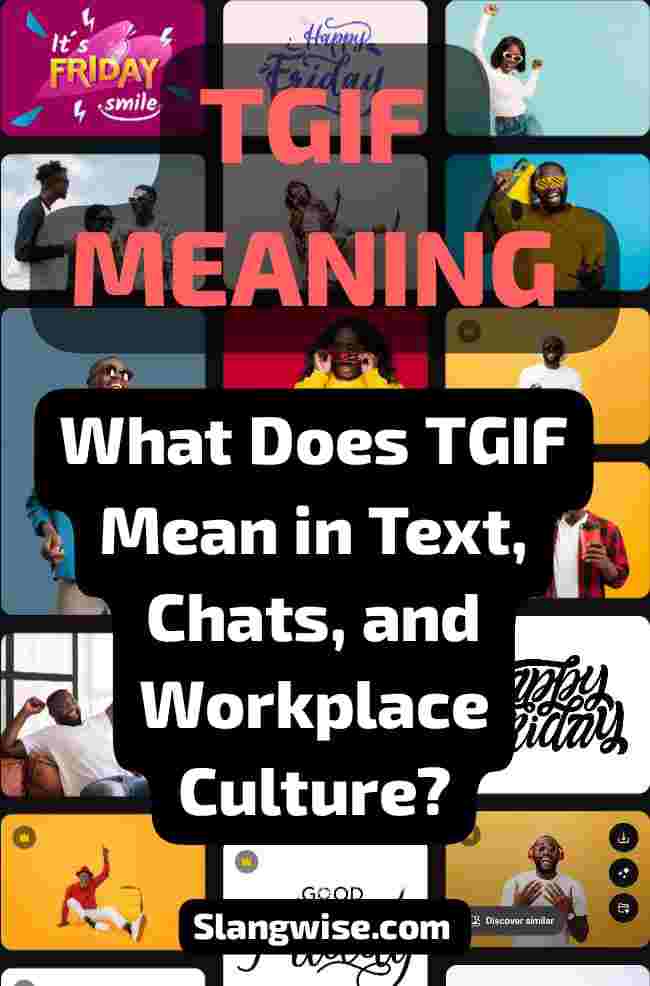TGIF meaning is a cultural shorthand that signals relief, celebration, or simple acknowledgment of the weekend’s arrival.
When asked What does TGIF mean, the clearest response is: TGIF stands for “Thank God It’s Friday.”
Use of this slang acronym appears across social media, text messages, office chats, and marketing copy as a quick, recognizable cue that the workweek has ended and downtime is near.
Table of Contents
In a Nutshell
- TGIF full form: Thank God It’s Friday.
- Primary uses: express relief, mark the start of the weekend, or add playful tone to messages.
- Where TGIF meaning in text appears: social posts, DMs, group chats, workplace channels, and promotional content.
- Tone: casual and celebratory, though usage can vary by audience and context.
TGIF meaning and origin
The TGIF full form; Thank God It’s Friday, emerged as popular slang during the late 20th century, when weekend leisure became increasingly central to work-life culture.
The slang phrase gained mainstream visibility through television, radio, and later social media. Over time, TGIF moved from spoken exclamation to textual abbreviation, offering convenience in short-form communication.
Marketing campaigns and Friday-themed events helped cement TGIF as an enduring part of modern vernacular.
TGIF meaning in text: common uses and examples

The TGIF meaning in text shifts slightly depending on context. Several common scenarios illustrate typical use:
- Casual relief: “TGIF – finally time to relax.” Signals end-of-week relief after a demanding schedule.
- Social planning: “TGIF! Drinks at 7?” Used to propose weekend gatherings or casual meetups.
- Workplace banter: “TGIF – sprint review went well.” Conveys brief celebration while acknowledging professional context.
- Marketing & promotions: “TGIF deals: 20% off through Sunday.” Brands use TGIF to inject timely energy into campaigns.
Note: Simple additions such as emojis (🎉, 🍻, 😌) or a short reason for celebration amplify tone and clarify intent. In environments where tone requires neutrality, avoiding TGIF may preserve professionalism.
Tone, etiquette, and situational awareness
Applying TGIF selectively preserves both levity and professionalism.
TGIF functions best when audience and context are considered:
- Professional settings: TGIF works in casual team channels or internal channels focused on culture. In formal announcements or client-facing communications, replacing TGIF with neutral phrasing, such as “end of week” or “weekend update”; maintains tone appropriateness.
- Cross-cultural contexts: Not all cultures emphasize the Friday–Saturday weekend model. When addressing international audiences, using TGIF without cultural awareness can confuse recipients or appear tone-deaf.
- Crisis situations: TGIF should be avoided when serious issues dominate workflow. Celebratory messaging during outages, emergencies, or organizational change risks appearing insensitive.
- Audience sensitivity: For mixed-role groups where hierarchy exists, brief, inclusive language often serves better than casual exclamations.
Variations and related expressions
Related abbreviated expressions and alternatives include:
- TGI (Thank God It’s…) used with different days for specific contexts (rare).
- Fri-Yay — playful variation that emphasizes excitement.
- “Happy Friday” — neutral, polite alternative for formal contexts.
- “Weekend vibes” — culture-forward phrase popular on social platforms.
Selection among these options depends on brand voice, audience, and the desired level of formality.
How TGIF performs in marketing and social media
Brands often leverage TGIF to create timely, shareable content.
When deployed thoughtfully, TGIF-themed content increases engagement and reinforces cultural timing. Effective TGIF campaigns do the following:
- Align with audience mood. Promotions that offer convenience, leisure, or relaxation match the Friday mindset.
- Provide immediate value. Limited-time offers tied to TGIF messaging increase urgency and relevance.
- Maintain brand voice. Casual TGIF copy works for lifestyle and consumer brands; conservative industries benefit from toned-down phrasing.
- Respect timing. Posting TGIF content on Friday mornings or early afternoons yields the best resonance.
Final Thought
TGIF remains a compact, culturally resonant acronym that captures end-of-week relief, social momentum, and weekend anticipation. Proper use depends on audience, timing, and tone.
When TGIF aligns with context and cultural norms, the acronym serves as an efficient way to mark transition from work mode to leisure mode and to inject light-hearted energy into messages.
FAQs
What does TGIF mean in text?
TGIF means “Thank God It’s Friday.” In text, the acronym signals relief or celebration at the arrival of the weekend.
What is the TGIF full form?
The TGIF full form is “Thank God It’s Friday.”
Is TGIF appropriate for workplace messages?
TGIF suits casual internal channels and team culture messages. In formal client communications, choose neutral alternatives such as “Happy Friday” or “End-of-week update.”
Are there cultural considerations when using TGIF?
Yes. Weekend days vary globally. Slow adoption of TGIF in regions with different weekend structures can lead to confusion. Cultural awareness is advised.

